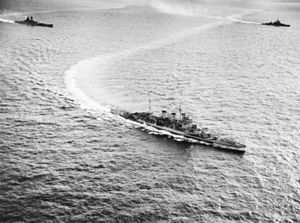HMS Renown (1916)
 HMS Renown operating with HMS Valiant (right distance), French battleship Richelieu (left distance) in the Indian Ocean, 12 May 1944
| |
| History | |
|---|---|
| Name | HMS Renown |
| Ordered | 30 December 1914 |
| Builder | Fairfield Shipbuilding & Engineering Co. Ltd., Govan, Scotland |
| Laid down | 25 January 1915 |
| Launched | 4 March 1916 |
| Commissioned | 20 September 1916 |
| Stricken | 1948 |
| Fate | Sold for scrapping 19 March 1948 |
| General characteristics | |
| Class and type | Renown class battlecruiser |
| Displacement | 32,000 tons |
| Length | 794 ft (242 m) |
| Beam | 90 ft (27 m) |
| Draught | 31.75 ft (9.68 m) |
| Propulsion | Geared turbines, 4 shafts, 120,000 shp (89 MW) |
| Speed | 31 knots (57 km/h) |
| Range | 3,650 miles (5870 km) |
| Complement | 1,181 officers and men |
| Armament | list error: <br /> list (help) 6 × 15 in /42 (381 mm) (3×2) 20 × 4.5 in (114 mm) (10×2) 24 × 2-pdr (40 mm) pom-pom (3×8) 20 mm AA (number varied) |
| Aircraft carried | 4 |
| Aviation facilities | 1 double-ended catapult launcher |
HMS Renown was the lead ship of the two 26,500-ton Renown class battlecruisers of the Royal Navy, the other being HMS Repulse. Both ships were originally to be built as Revenge class battleships along with a third ship named HMS Resistance, but the orders were suspended after the First World War broke out. A few months later First Sea Lord Jackie Fisher used his influence to have Renown and Repulse restarted to a new design as battlecruisers.
She was built by Fairfield Shipbuilding & Engineering Co. Ltd. at Govan, Glasgow, Scotland. Completed in September 1916, she was too late to serve in the Battle of Jutland but served with the Grand Fleet in the North Sea during the remaining two years of World War I. The future First Sea Lord John H. D. Cunningham served aboard her for a period as senior navigator.

In 1920-21, following a refit, she carried the Prince of Wales on voyages to Australia, New Zealand and the United States. During 1923-26, she was extensively refitted to increase her protection against gunfire and torpedoes, and in 1927 also carried the Duke and Duchess of York to Australia and New Zealand.
After a decade of further service, Renown was again reconstructed, greatly changing her appearance and giving her a modern anti-aircraft gun battery, much enhanced aircraft-handling facilities, and up-to-date gunfire controls. This work was completed in September 1939, just after the outbreak of the Second World War. During this work she picked up the Nickname of HMS Refit. (The ship had first been nicknamed 'HMS Refit' as early as 1916, due to the hurried addition of extra armour in response to the defensive weaknesses of battlecruisers revealed by losses at Jutland. Her sister-ship Repulse had similarly been nicknamed 'HMS Repair').
Renown's high speed made her a valuable asset during World War II. In late 1939, she was sent to the South Atlantic to search for the German pocket battleship Admiral Graf Spee. She then covered minelaying operations along the Norwegian coast in early April 1940 and, on the 9th of that month, engaged the German battlecruisers Scharnhorst and Gneisenau, damaging the latter with three hits and getting hit twice in return. Later in 1940 and into 1941, she operated with Force "H", based at Gibraltar, to provide strategic presence in both the Atlantic and Mediterranean. While with Force "H", she participated in a bombardment of Genoa, Italy, in February 1941. In May, she took part in the hunt for the German battleship Bismarck.
After Home Fleet service in 1942-43, Renown was sent to join the Eastern Fleet in the Indian Ocean. During this period she also carried Churchill to and from a pre-Tehran conference in America, and was granted a set of handbells for use at or before church services by the people of Leicester, with whom she had become associated in Warship Week 1942 (commemorated by a letter from the captain, still on display at Leicester Cathedral). Operating from Ceylon in 1944-45, she helped contain the Japanese in the East Indies.
Renown was one of only four battlecruisers to survive World War II — the others being the two US Navy Alaska class "large cruisers" built during the war and the Turkish TCG Yavuz which had been launched as SMS Goeben in 1911. Renown had brief post-war service in British waters as a training hulk as part of the stokers' training establishment HMS Imperieuse, and was sold for scrapping in March 1948. She was the last of Admiral Jackie Fisher's battlecruisers to see the scrapyard, outlasting HMS Furious by days.
References
- This article incorporates text from http://www.history.navy.mil/photos/sh-fornv/uk/uksh-r/renown.htm, a public domain publication of the U.S. Naval Historical Center.
